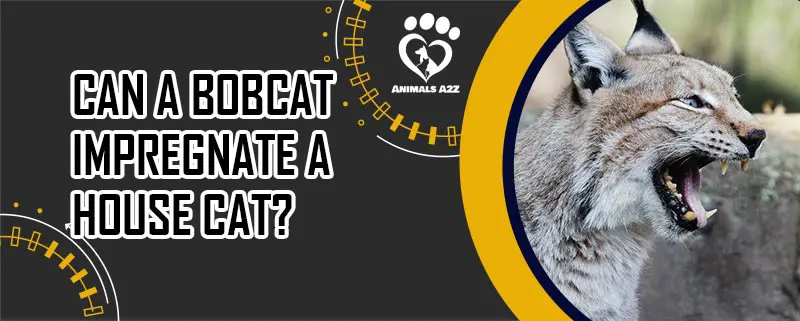The Bobcat (Lynx rufus), also called the red lynx, is a wild cat breed native and abundant in North America, particularly the Southern Californian region. But even though these cats have a growing population, it’s very rare to see one because they prefer to keep themselves hidden in their natural habitat.
Table of Contents
Bobcats impregnating house cats
However, there are a number of reports that Bobcats have impregnated domestic cats. Still, experts lack scientific evidence to prove that these two different cat breeds are capable of interbreeding. Many believe that the Pixie-bob cat breed came from a mix of Bobcat and a domestic cat.
The Bobcat
Bobcats got their name from their tails, which are very short or “bobbed” tails.
Color
These cats can come in various coat colors, but their most common color is pale-brown to grayish-brown, with black stripes on the body and dark-colored bands on their tails and front legs. Bobcats come in a spotted pattern, which serves as their camouflage in the wild. They have cream-colored underparts, including their chins and lips.
They also have a distinctive pair of black-tipped ears with black, short tufts of hair. These cats’ coat patterns are very interesting because they are like fingerprints. Each pattern is unique from other Bobcats, which can be used for their identification.
Facial features
Bobcats faces appear larger than their actual size because of the ruffs of hair that extend beneath their ears. Their eyes are yellow with black, round pupils that widen when they hunt at night. Their face base color can come in yellow, reddish-brown, or gray, and their nose has a pinkish-red color.
Size
Bobcats are medium-sized felines. They are the smallest among the midsize Lynx genus.
Adult Bobcats can reach 47.5 cm to 125 cm long, averaging 82.7 cm. This measures from the head to the base of their tail. Their short stubby tail, which appears bobbed, usually measures between 9 cm to 20 cm.
Adult Bobcats are relatively taller than typical domestic cats. They can reach a height from 30 cm to 60 cm from toes to their shoulders. Male Bobcats are larger than females. Their weight ranges from 14 pounds to 40 pounds. On the other hand, female Bobcats have an average weight from 8.8 pounds to 33.7 pounds.
Personality of a Bobcat
Bobcats are experts in hiding. This gives them an extra advantage when hunting for prey. These cats are territorial. They don’t like being observed by humans.
Bobcats have a good sense of smell and a very sharp vision and hearing. They can easily tell if someone or something is lurking in the bush or rocks around their territories. They are excellent climbers and can be good swimmers too when needed, even if they don’t like water that much.
Bobcats are independent and solitary. Their territories have a very wide range that can span up to two square miles. Being territorial, they don’t like other wildcats or other animals roaming in the range of their home. These cats will fight for their territory to protect it. However, overlapping Bobcat territories may occur, but it happens only with male and female Bobcats and never with two male Bobcats.
The Pixie-bob cat
The Pixie-bob cats are medium to large size cats. They are sturdy and look very much like wild Bobcats. These wild-looking cats are generally domestic cats and there are no restrictions on the ownership of these exotic looking felines. Pixie-bobs can make good companions because they are playful, affectionate, and loyal.
Origin
The first Pixie-bob cat is believed to be a result of the interbreeding of a wild Bobcat and a barn-cat. This happened in 1985. Carol Ann Brewer, the barn cat’s owner, named the female kitten “Pixie.”
This has become the foundation cat for the Pixie-bob cat breed. However, even though there’s no scientific evidence that the Pixies actually are half Bobcat, this cat breed is still widely accepted and believed to be a bobcat-mix by cat breeders.
Physical attributes of Pixie-bob cats
Body build and color
Pixie-bob cats have a lot of resemblance to wild Bobcats. They have a muscular, long, and lean body. Their color is much like that of Bobcats. Their coats have a spotting pattern with a slightly tan color or a reddish-brown color. Their tails are very short, as implied in their name “bob.”
Facial features
Their face is medium-wide and pear-shaped. Some Pixie-bob cats have black-tipped ears. They have black fur on the bottom of their paws and heavy tuft hairs on their ears.
Their eyes can come in different colors, including gooseberry green or hazel-brown.
Size
Male Pixie-bob cats are usually larger than females; however, they can both grow up to 30 cm to 33 cm tall. These long-bodied, muscular cats can weigh between 14 pounds to 25 pounds.
Personality of Pixie-bobs
The exotic-looking Pixie-bob cats have a domestic personality. They are affectionate and love being around their owners. They enjoy playing and also like laid-back activities with their family members.
These cats have been labeled as “dog-like” in temperament because they create a strong bond with their families and can get along well with children and other house pets. They can be taken out for a walk with a leash and also enjoy car rides.
Common questions about mixing domestic cats with wild cats
Can wild cats breed with domestic cats?
Yes, wild cats can breed with domesticated cats, and the most well-known example of this is the African Serval cat. Many people claim that African Servals are loving pets, but their natural predatory needs and large size make it challenging to keep them confined in one household safely.
Another famous example of a wild and domestic cat offspring is the Savannah cat that exhibits a dog-like personality.
Can a cat breed with a lion?
You can’t find feline hybrids in nature, so even if domesticated cats don’t technically breed with lions, if they got forced to mate, they would. Famous examples of domestic and wild cat hybrids are the African Serval cat and Savannah cat. Although domesticated and feral cats can breed, they don’t cross the species line, like how humans don’t get drawn to chimpanzees.
What big cat is closest to domestic cats?
The Siberian tiger is the largest of the world’s big cats and weighs up to 800 pounds (360 kilograms) compared to the mere 550 pounds (250 kilograms) of African lions. These tigers are also known as Panthera Tigris Altaica. They roughly share 95.6% of their DNA with much smaller and tamed domesticated cats, making them the closest big cat to domestic felines.
Final thoughts
Bobcats can impregnate a house cat. There are records proving this scenario, and one good proof is the Pixie-bob cat breed. The Pixie-bob has a very strong resemblance to the Bobcat’s appearance. From their body structure, size, and coat color and pattern.
Although we lack scientific data, we can say that it’s possible to happen and or has been happening to other parts of the world. The thing is, the cat owners don’t get it recorded, or they’re not aware. This can also be supported by domestic cat hybrids, such as the famous Bengal and Savannah cats, which came from the mix of wildcats and domestic cats.


